
USCGC Mesquite (WAGL/WLB-305) was the lead ship in the Mesquite class of seagoing buoy tenders operated by the United States Coast Guard. She served in the Pacific during World War II, and spent the rest of her Coast Guard career in the Great Lakes. She ran aground and was wrecked in December 1989 off the Keweenaw Peninsula in Lake Superior. She was scuttled nearby as a recreational diving attraction.

The Keeper class of coastal buoy tenders consists of fourteen ships built for and operated by the United States Coast Guard. The ships were launched between 1995 and 1999 and all remain in active service. Their primary mission is to maintain thousands of aids to navigation, both buoys and land-based. Their secondary missions include marine environmental protection, search and rescue, law enforcement, and light ice-breaking.

The USCGC Acacia (WAGL-406/WLB-406) is an Iris-class 180-foot seagoing buoy tender operated by the United States Coast Guard. Acacia was a multi-purpose vessel, nominally a buoy tender, but with equipment and capabilities for ice breaking, search and rescue, fire fighting, logistics, oil spill response, and other tasks as well. She spent almost all of her 62-year Coast Guard career on the Great Lakes. After decommissioning she became a museum ship in Manistee, Michigan.

United States Coast Guard Cutter is the term used by the U.S. Coast Guard for its commissioned vessels. They are 65 feet (19.8 m) or greater in length and have a permanently assigned crew with accommodations aboard. They carry the ship prefix USCGC.
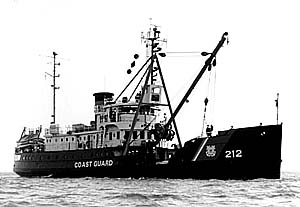
The United States Coast Guard Cutter Fir was the last lighthouse tender built specifically for the United States Lighthouse Service to resupply lighthouses and lightships, and to service buoys. Fir was built by the Moore Drydock Company in Oakland, California in 1939. On 22 March 1939, the U.S. Lighthouse Tender Fir was launched. She was steam driven with twin screws, 175 feet (53 m) in length, had a beam of 32 feet (9.8 m), drew 11 feet 3 inches (3.43 m) of water, and displaced 885 tons. Fir was fitted with a reinforced bow and stern, and an ice-belt at her water-line for icebreaking. She was built with classic lines and her spaces were lavishly appointed with mahogany, teak, and brass. The crew did intricate ropework throughout the ship. The cost to build Fir was approximately US$390,000. Fir's homeport was Seattle, Washington for all but one of her fifty one years of service when she was temporarily assigned to Long Beach, California when USCGC Walnut was decommissioned on 1 July 1982.

USCGC Elm (WLB-204) is a U.S. Coast Guard Juniper-class seagoing buoy tender home-ported in Astoria, Oregon. She is responsible for maintaining aids to navigation on the coasts of Oregon and Washington, including the Columbia River.

USCGC Henry Blake (WLM-563) is a United States Coast Guard Keeper-class cutter based at Naval Station Everett in Everett, WA. Henry Blake's primary mission is the maintenance of 80 lighted, 39 unlighted, and 65 shore-based aids to navigation in the Puget Sound area and along the coast of Washington. Secondary missions include marine environmental protection, search and rescue, and homeland security. Henry Blake is assigned to the Thirteenth Coast Guard District.
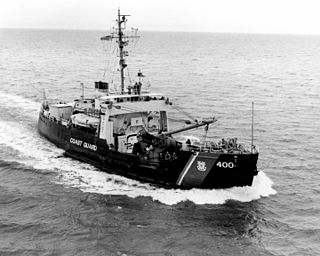
USCGC Salvia (WLB-400) was a United States Coast Guard Iris-class buoy tender in commission from 1944 to 1991. She operated in the Great Lakes and along the United States Gulf Coast during her career. Sold and renamed Brian Davis in 2020 for use as a memorial vessel, she was scuttled as an artificial reef in 2020.

USCGC Ida Lewis (WLM-551) is the lead ship of the United States Coast Guard Keeper-class of Coastal Buoy Tenders. Launched in 1995, she has spent her entire career maintaining navigational aids near her homeport of Newport, Rhode Island. Ida Lewis is assigned to the First Coast Guard District.
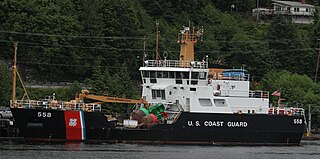
USCGC Anthony Petit (WLM-558) is a Keeper-class coastal buoy tender of the United States Coast Guard. Launched in 1999, she has served her entire career maintaining navigational aids in Southeast Alaska. She is assigned to the Seventeenth Coast Guard District.

USS YF-445 was a U.S. Navy covered lighter built in 1943 for service in World War II. Her most significant action during the war was to supply ships with food and water at the landing beaches of Operation Dragoon, the allied invasion of Southern France in 1944.

USCGC Marcus Hanna (WLM-554) is a Keeper-class coastal buoy tender of the United States Coast Guard. Launched in 1997, she is home-ported in South Portland, Maine. Her primary mission is maintaining 376 aids to navigation from Boston to St. John's Bay, Maine. Secondary missions include marine environmental protection, light icebreaking, search and rescue, and security. She is assigned to the First Coast Guard District.

USCGC Abbie Burgess (WLM-553) is a Keeper-class coastal buoy tender of the United States Coast Guard. Launched in 1997, she is home-ported in Rockland, Maine. Her primary mission is maintaining 366 aids to navigation from Boothbay Harbor, Maine to the Canadian border. Secondary missions include marine environmental protection, light icebreaking, search and rescue, and security. She is assigned to the First Coast Guard District.

USCGC James Rankin (WLM-555) is a Keeper-class coastal buoy tender of the United States Coast Guard. Launched in 1998, she is home-ported at the Coast Guard Yard in Baltimore, Maryland. Her primary mission is maintaining 361 aids to navigation in Upper Chesapeake Bay and its tributaries including the Eastern Shore of Maryland, the Potomac River, and the Annapolis area. Secondary missions include marine environmental protection, light icebreaking, search and rescue, and security. She is assigned to the Fifth Coast Guard District.
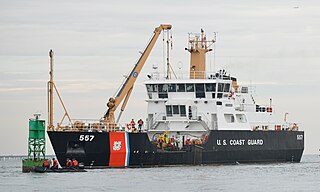
USCGC Frank Drew (WLM-557) is a Keeper-class coastal buoy tender of the United States Coast Guard. Launched in 1998, she is home-ported in Portsmouth, Virginia. Her primary mission is maintaining over 300 aids to navigation in lower Chesapeake Bay, the rivers that flow into it, and a potion of the North Carolina Coast. Secondary missions include marine environmental protection, light icebreaking, search and rescue, and security. She is assigned to the Fifth Coast Guard District.
USCGC Red Beech (WLM-686) was a Red-class coastal buoy tender designed, built, owned, and operated by the United States Coast Guard. She was launched in 1964 and homeported at Governors Island, New York. Her primary mission was maintaining 250 aids to navigation along the Hudson River, East River, Raritan River, Kill Van Kull, Arthur Kill, and throughout New York Harbor. Her secondary missions included search and rescue, light icebreaking, law enforcement, and marine environmental protection. Red Beech was initially assigned to the 3rd Coast Guard District, but was later moved to the 1st Coast Guard District when the 3rd was absorbed in a reorganization.

USCGC Red Oak (WLM-689) was a Red-class coastal buoy tender designed, built, owned, and operated by the United States Coast Guard. She was launched in 1971 and homeported at Gloucester City, New Jersey until Coast Guard Base Gloucester was closed in 1988. For the remainder of her career she was home-ported in Philadelphia. Her primary mission was maintaining over 300 aids to navigation in the upper Cheasapeake Bay and its tributaries including the Delaware, North East, Chester, Bohemia, Sassafras, and Susquehanna Rivers, and the C&D Canal. She was also responsible for refueling the Brandywine Shoal lighthouse. Her secondary missions included search and rescue, light icebreaking, law enforcement, and marine environmental protection. Red Oak was initially assigned to the 3rd Coast Guard District, but was later moved to the 5th Coast Guard District when the 3rd was absorbed in a reorganization.
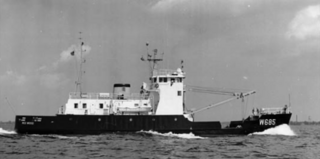
USCGC Red Wood (WLM-685) is a Red-class coastal buoy tender that was designed, built, owned, and operated by the United States Coast Guard. She was launched in 1964 and homeported at New London, Connecticut for most of her career. In March 1996 she moved to Philadelphia where she replaced the decommissioned USCGC Red Oak. Her primary mission while based in New London was maintaining over 200 aids to navigation from Watch Hill, Rhode Island to Execution Rocks at the west end of Long Island Sound. She also provided fuel and water to several lighthouses including the Falkner Island Lighthouse. Her secondary missions included search and rescue, light icebreaking, law enforcement, and marine environmental protection. Red Wood was initially assigned to the 3rd Coast Guard District, but was later moved to the 1st Coast Guard District when the 3rd was absorbed in a reorganization.

USCGC Red Birch (WLM-687) is a Red-class coastal buoy tender that was designed, built, owned, and operated by the United States Coast Guard. She was launched in 1965 and initially homeported at San Francisco. Her primary mission was maintaining 160 aids to navigation in San Francisco, San Pablo, and Suisun Bays, and in the San Joaquin River. Red Birch also brought supplies to the Farallon Island lighthouse. In 1976 the Coast Guard reassigned her to Baltimore, Maryland, where she spent the rest of her career. There she maintained over 300 aids to navigation including several lighthouses. Her secondary missions included search and rescue, light icebreaking, law enforcement, and marine environmental protection.
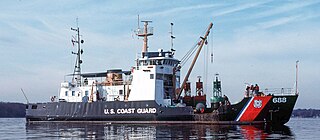
USCGC Red Cedar (WLM-688) is a Red-class coastal buoy tender that was designed, built, owned, and operated by the United States Coast Guard. She was launched in 1970 and homeported in Norfolk, Virginia. Her primary mission was to maintain over 400 aides to navigation in Chesapeake Bay, Tangier Sound, the Potomac, Rappahannock, York, and James Rivers, and other nearby waterways. Her secondary missions included search and rescue, light icebreaking, law enforcement, and marine environmental protection. She was assigned to the 5th Coast Guard District.





















